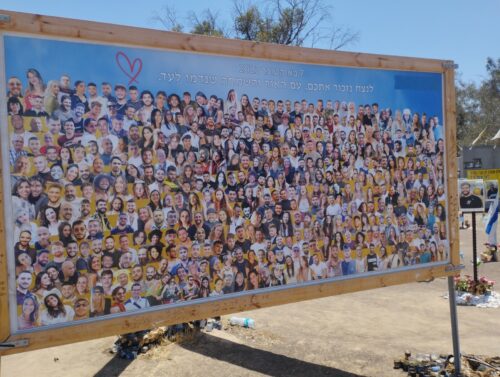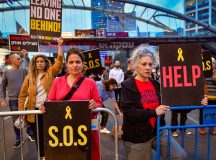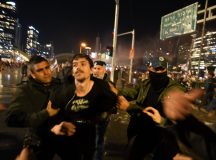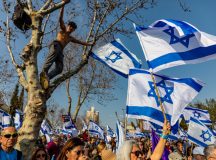Fathom Deputy Editor Calev Ben-Dor reflects on his visit to Israel’s south, and the sites of the 7 October massacre.
This photo is ‘deep fake’
We are standing in a large sunlit square of gravel and memorials that was once the Sderot police station. After being overrun by Hamas gunmen who killed 35 officers and civilians, a command was given for an Israeli tank to destroy the building. Around us are candles and pictures of those policemen who died defending the station.
The image of Hamas gunmen in a pickup truck driving around the southern city of 40,000 residents is one of several totemic pictures of 7 October. Public intellectual Micha Goodman recounts when he first saw it. It was early morning, everyone in his neighbourhood had heard the sirens, and a worried pedestrian approached Goodman, thrust a smartphone into his face and asked him what was happening. ‘We are under attack’ Goodman concluded. ‘But it’s likely a cyber-attack from Iran. This photo is deep fake. They want us to panic and think Hamas gunmen are in Sderot.’ I think about this anecdote often. Not because of how inaccurate it was, but because at that moment it reflected Israelis’ (limited) 6 October range of imagination. It was genuinely more believable that we were under a cyber-attack from Iran than there actually were Hamas gunmen in Sderot. That scenario was un-imaginable.
Between the War of Independence and the Shoah
Leaving Sderot, we head onto Route 232 in the direction of the site of the Nova festival. The area after the Alumim Junction became a death trap for those fleeing in cars along the road. A Zaka volunteer said in an interview that the stretch of road that usually takes 10 minutes to walk took him and his colleagues seven hours to traverse because of the number of charred bodies in the vehicles. Later we would visit Tekuma, the location where those cars were brought. At the entrance there stood scorched remains of an ambulance from Nova that was destroyed by an RPG (with a dozen people inside). Some cars had broken dashboards and were littered by bullet holes. One, a white Toyota Corolla owned by Keith and Aviva Siegel of Kfar Azza, was used by Hamas to take them hostage (it was later discovered by IDF forces at Shifa hospital). Several dozen vehicles are burned beyond any recognition. The guide tells us how a special contraption collected all the remaining human ash before being taken to Rishon Letzion and buried in a mass grave.
The site reminds me of some gruesome combination of the Auschwitz shoe memorial and the skeletons of the 1948 armoured truck convoys on Route 1 that sought to break the siege of Jerusalem. Perhaps that’s not coincidental. 7 October has parts of both – a continuation of the War of Independence on the one hand, and the brutality of the Shoah on the other. It’s certainly the first time Jews have been burned en masse since that dark period of Jewish history.
Israelis aren’t going home because we are home
I didn’t imagine that the miguniot, the roadside shelters, would be this small. We stood in one – that couldn’t have been larger than 2.5 x 1.5 metres – in which Hirsh Goldberg-Polin lost his arm and his childhood friend Aner Shapiro and 15 others lost their lives. After heroically throwing out grenades seven separate times from the shelter, the explosion of the eighth killed Aner, following which the hiding place was sprayed with bullets. Hirsch and three others were taken to Gaza where they remain. Several festival-goers survived under the dead bodies. How a couple of dozen youths fitted in this area is beyond me. The shelter is now full of memorial candles and photos.
Aner’s story of heroism is far from the only one from that day. It includes hundreds of Israelis of all stripes. Minivan drivers such as Yosef El Zaidneh and his late cousin Abed al-Rahman Alnasarah who rushed towards the festival to rescue those fleeing; Fifty-four-year-old Chief Supt. Avi Amar, who fought in Sderot, Kibbutz Kfar Aza, and finally Kibbutz Be’eri where he was killed; Livni Ben-Yehuda, the first female infantry commander and head of a border defence battalion, who stood by the fence breach trying to stem the tide of terrorists entering Israel; retired IDF vet Eran Masas, 46, from Kiryat Ata near Haifa, who drove 200 kilometres to Sderot to help and ended up directing Nova survivors to safety and ultimately collecting bodies; twenty-three-year-old Awad Darawshe, a paramedic at the Nova Festival who refused to flee and believed he could talk Hamas down; the thousands of Israeli soldiers who, without waiting to be conscripted, took their gun, put on their uniforms, and headed south to stop the massacres.
Israel suffered a deadly surprise that day. But I believe Hamas also experienced the unexpected. The resistance axis – Hamas, Iran, Hezbollah, the Houthis – as well as their Keffiyeh-wearing professional social justice warrior allies that Khameini recently praised as being on the right side of history, view Israel as a western colonial implant in the region. The natural corollary of that diagnosis is that armed struggle will ultimately prevail. Because if one acts brutally enough against colonialists, if the Algerian National Liberation Front kill enough French in the 1950s and ‘60s, then it doesn’t matter if Algeria had formally been declared part of France for the last hundred years. It’s irrelevant that one million Pieds-noirs lived in the country. With enough strategic patience and armed resistance, in the end, the French will go home. Because that’s what occupiers and colonialists ultimately do. ‘The history of this region has proven time and again that occupation is temporary,’ said Hamas co-founder Mahmoud Zahar, ‘Thousands of years ago, the Romans occupied the land and eventually they left. The Persians, the Crusaders, and English also came and went. The Zionists have come, and they too will leave.’ That’s simply what colonialists do. (Unsurprisingly Zahar proffered few details regarding from whom the Romans occupied the land).
Inspired by these precedents, Sinwar is, to borrow the title from Alistair Horne’s classic book about the Algerian War, acting out his own Savage War of Peace. He likely expected Israelis to flee – to run away from the bullets not towards them (we also know he expected Arab citizens of Israel to rise up, and they did quite the reverse). But Israelis aren’t like the French in Algeria. We aren’t going home, because we are home. And the brutality of that day – not simply a bug but an integral part of the Hamas system – made Israelis less rather than more inclined for territorial compromise.
They thought two bodies were one
Eran Masas wasn’t the only person who collected some of the 360 abused, disfigured and charred bodies from Nova. A Zaka volunteer relates finding 21 burned bodies inside a migunit where it took 40 volunteers three hours to separate them into body bags. Walking around Nova today, the memorials are spread out. In the open areas between the Eucalyptus trees stand photos of those murdered. Some families have added larger posters of their loved ones, including sayings about their joie de vivre, or smile, or faith in God / love of humanity.
A collage of headshots of those killed at the festival, Sergeant Pepper album cover style, stands in the center. One spot details the timeline of 25 year old Shani Gabbay’s last hours. Having fled the party and been shot in the leg, Shani returned to Nova to be treated in an ambulance before it was destroyed by an RPG. 47 days later was she was declared dead (rather than missing), her remains mistakenly buried with someone else who had been in the destroyed ambulance. We heard several stories in which two bodies were so badly charred that emergency services initially believed them to be one.
Revenge or Allahu Akhbar?
In December 2023, I brought a Palestinian East Jerusalemite to speak to a gap year group I teach about the conflict. Samer was young, amiable and eloquent, and beguiled us with tales of the difficulty of living as a Palestinian resident in what Israel sees as its eternal indivisible capital. And then we got to 7 October. ‘What happened on that day was terrible’ Samer began, before reaching the dreaded ‘but’. ‘But Israel treated these people like animals. They were caged up within Gaza,’ he continued. ‘So is it surprising that when they broke out they should behave that way? Those carrying out the acts on October 7,’ Samer determined, ‘were chanting “revenge, revenge.”’
In his 2003 book Terror and Liberalism, American writer Paul Berman describes a difficulty within liberal circles of internalising the existence of evil and totalitarian movements. ‘There are no pathological or irrational movements, no movements yearn to commit slaughters, no movements that yearned for death,’ writes Berman. ‘If such movements do exist it’s because they’ve been conjured into existence by other forces.’
For Berman, this blindness represented
unwillingness, sometimes an outright refusal, to accept that from time to time mass political movements do get drunk on the idea of slaughter. It was a belief that, around the world, people are bound to behave in more or less reasonable ways pursuit of normal and identifiable interests. It was a belief of the world is by and large a rational place.
This article of faith has atrocities indelibly linked to oppression (and the greater the atrocity the greater the oppression that caused it). In this world, the only rational way to understand the Hamas massacres is through the lens of Israeli oppression and historic injustice.
Yet those drugged up elite Nukhba fighters determinedly moving from safe room to safe room hunting families, Einsatzgruppen style, and slinging grenades into over-crowded miguniyot, weren’t shouting revenge. As the videos they so proudly uploaded to the web demonstrate, they were shouting Allahu-Akbar. ‘Hamas is openly committed to a racist and genocidal ideology,’ Berman said in an interview after 7 October. ‘But many people do not want to let go of their idea that the world is a place where there are simple causes and effects, and the causes are always material, and doctrines do not count for anything.’
Wandering around the many memorials at Nova, I thought of how so much of our understanding of that day can be divided between ‘Revenge’ or ‘Allahu-Akbar’ – the former focused on the righting of historic wrongs, the second motivated by a fundamentalist Islam thrilled by killing Jews. The answer we provide influences the conclusions we draw on the problem and its potential solution. And in too many cases, the self-defined liberal left is getting it wrong.
‘Bring them home now’, or ‘total victory’?
Bus line 97 that I take home from the Jerusalem train station isn’t particularly long but passes through demonstrations that give a taste of today’s Israel. In a large tent located in the square by Cinema City and the Foreign Ministry stands the Gevurah Forum for Families of Fallen Heroes. They believe a ceasefire agreement before Hamas is completely destroyed (even if it facilitates the release of the hostages) represents a dangerous humiliation and will incentivise terrorist groups to carry out further attacks. ‘In their death they commanded us victory,’ read the posters of soldiers who have fallen in battle since the war began.
Further down the road, opposite the Knesset – which last night welcomed Benny Gantz back to the opposition benches and passed (in its first reading) a bill that would continue to exclude the Haredim from army service – stood several antigovernment demonstrators. One poster critiqued the continued absence of Haredi IDF enlistment. ‘Draft Dodgers Be’Ezrat Ashem’ (with the help of the guilty one [i.e. PM Netanyahu] – it’s a play on the phrase Be’ezrat Hashem, with God’s help.) One sticker says ‘Victory is the return of our children’ [i.e. the hostages]. The most prominent slogan remains ‘you are in charge, you are guilty,’ directed at Netanyahu, who is yet to formally admit to any responsibility for 7 October.
Getting off the bus, I pass a tent for the hostages, with yellow ribbons and a call for them to be freed immediately. The feeling here (disregarding Sinwar’s apparent complete disinterest in a deal) is that the government has abandoned them. Closer to home, as I cross the street on which the PM’s residence is located, are names of the hostages written in chalk on the road. Next to each one is the word slicha, ‘sorry’.
The more I learn about the heroism of 7 October, the greater my belief that we Israelis need to be worthy of the sacrifice. That may not help us navigating between those calling for total military victory or bringing the hostages home now. But it should help us in formulating a new discourse that fully reflects the bravery, patriotism and social responsibility of all those who continue to risk their lives so we can live ours.



































